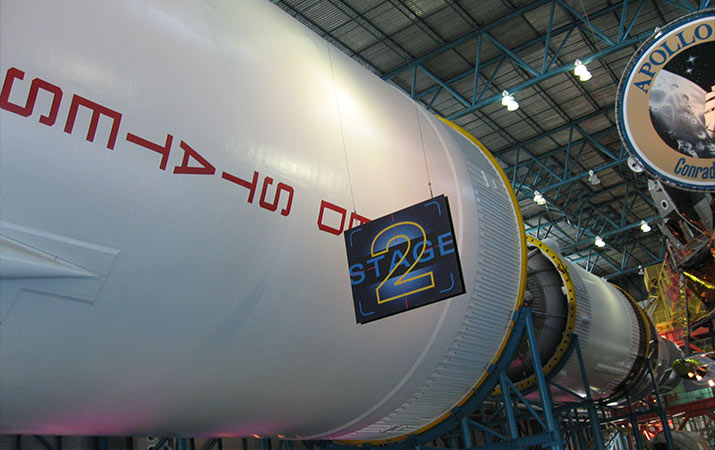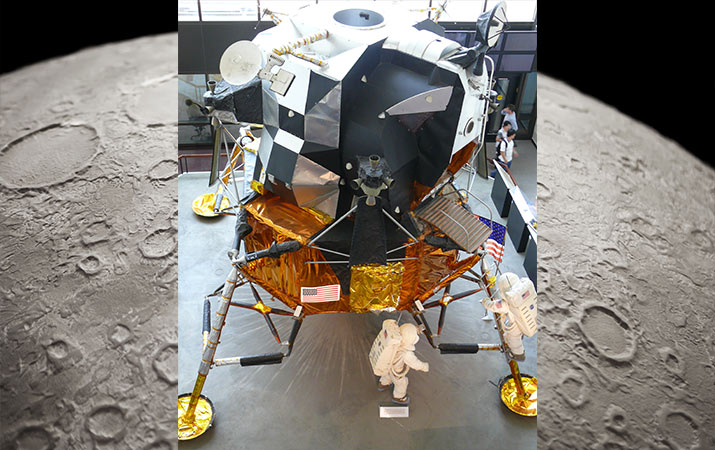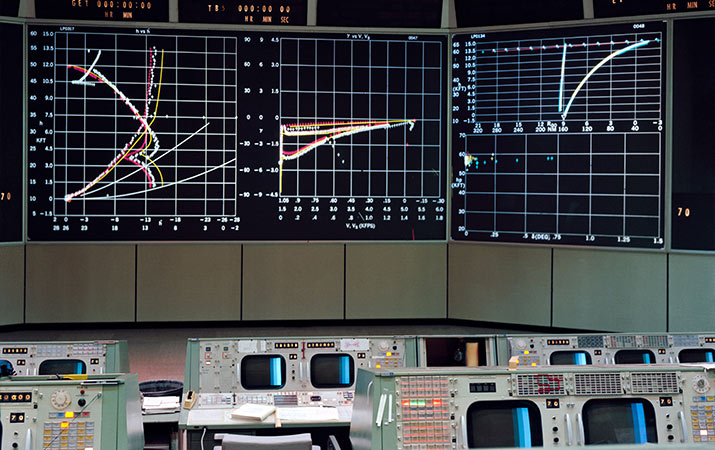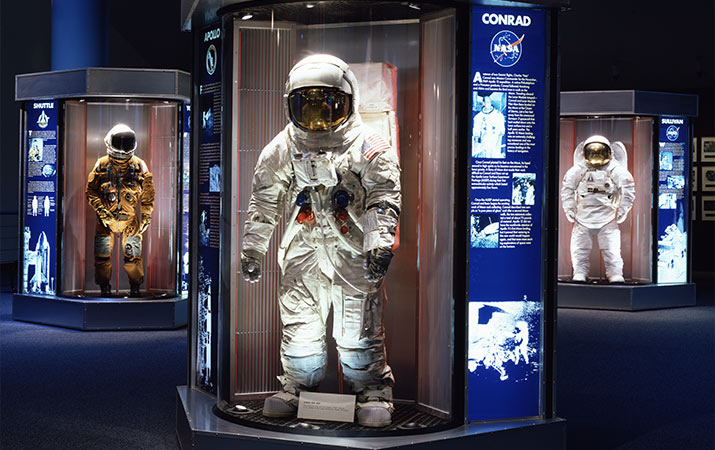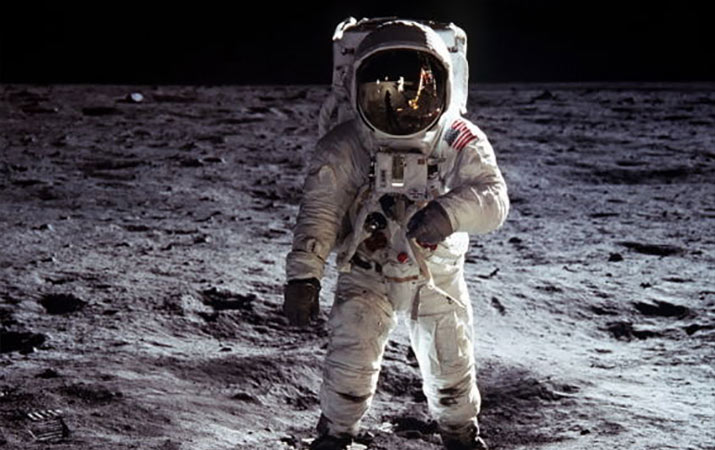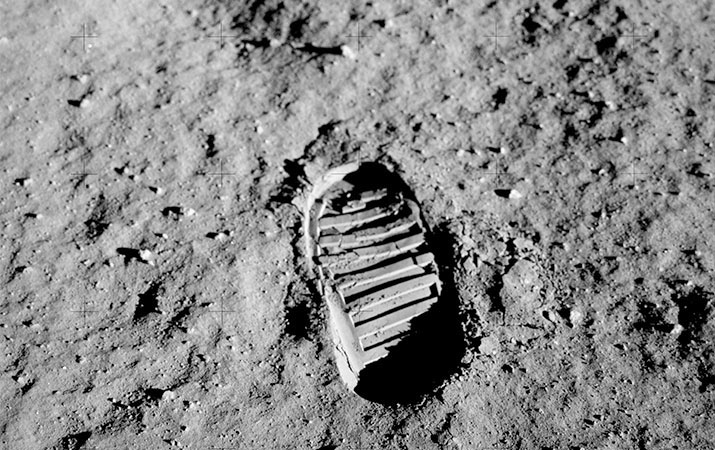July 20, 1969, fifty years ago, the United States landed a spacecraft on the moon.
“I believe that this nation should commit itself to achieving the goal, before this decade is out, of landing a man on the moon and returning him safely to the earth. No single space project in this period will be more impressive to mankind, or more important for the long range exploration of space.
President John F. Kennedy spoke these words on May 25, 1961, setting in motion the Apollo space program, with a mission, and challenge, to go to the moon.
After the successful Apollo 11 moon landing, there were six more Apollo missions.
The next phase of space exploration was a reusable space shuttle to bring astronauts and cargo to the International Space Station, launch satellites, do research and experiments in space. NASA also launched space probes and Hubble Space Telescope to send back photos and data of our solar system and beyond.
This summer, visit museums to see rockets, lunar capsules, modules and rovers, and read books about space exploration and incredible adventure of going to the moon.
Kennedy Space Center, Florida
Kennedy Space Center is the home base of NASA (National Aeronautics and Space Administration), which oversees the space program, and Cape Canaveral is the launch site for all manned spaceflight.
The center is a working space facility, and the visitor complex includes launch pads, rockets, exhibits of space exploration, past and present.
In the Apollo/Saturn V complex, kids will see the gigantic Saturn V rocket that launched missions to the moon, along with the service and lunar modules, and command module that returned to earth from moon missions.
Kids can also touch a real moon rock, see events of the 1969 moon landing, lunar spacecraft and spacesuits,
Space Shuttle Atlantis gallery displays the space shuttle named Atlantis, with doors open, the way it would look when it docked at the space station.
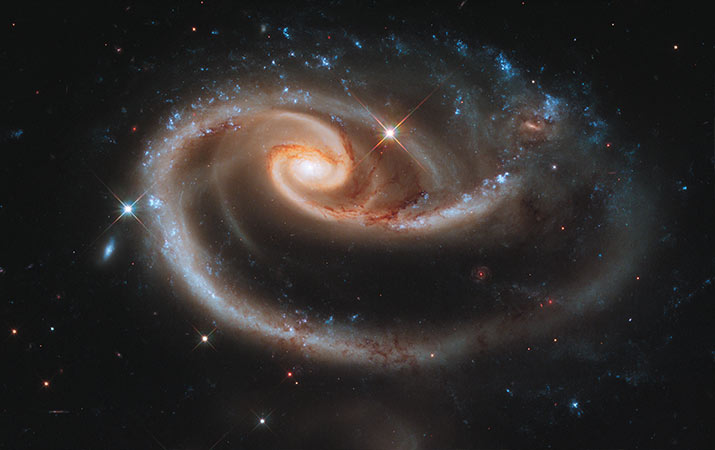
In the Hubble Space Telescope Theater is a replica of the telescope and images from space.
Tip: Florida Space Coast – Cape Canaveral is an easy day trip from Orlando.
National Air and Space Museum, Washington DC
The National Air and Space Museum in Washington DC is a “biggie.” On display is a real lunar module (used for testing), set up the way it would have looked when the astronauts first landed on the moon, command module Columbia from Apollo 11, space suits and lunar roving vehicle (LRV) used in later moon missions, Apollo 15 -17.
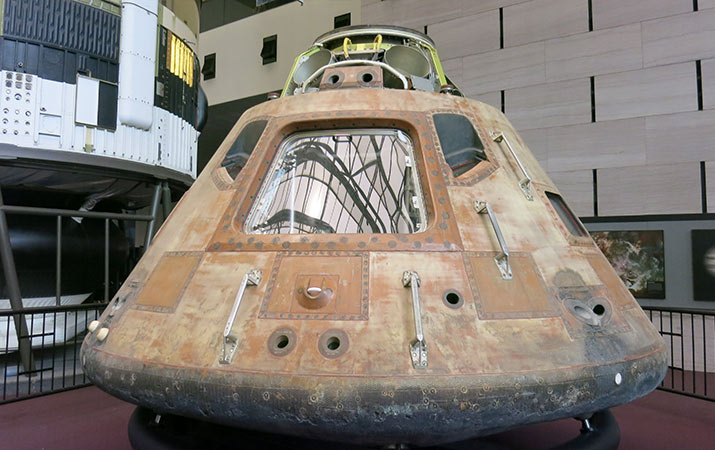
Photo above is the Columbia command module used in the 1969 Apollo 11 mission, astronauts “home base” for 8 days, splashing down in the ocean at the end, “returning safely to earth.”
Seeing the module right in front of you, it’s hard to comprehend where it’s been, transporting people to the moon and back!
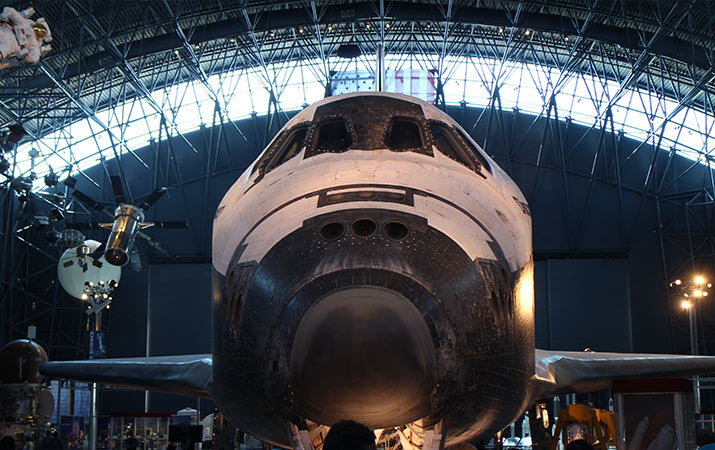
In the National Air And Space Museum second facility near Dulles Airport, the Steven F. Udvar-Hazy Center, check out the space shuttle Discovery.
Space Center Houston
NASA Mission Control for Apollo missions was based in Houston Texas.
On July 20, 1969, when Neil Armstrong and Buzz Aldrin touched down on the moon in the lunar module (call sign Eagle), Armstrong radioed a message to mission control: “Houston, Tranquility Base here. The Eagle has landed.”
At the Space Center Houston, kids can step into the restored Apollo Mission Control Center, view an extensive collection of spacesuits for both men and women astronauts, including Neil Armstrong’s spacesuit, and touch moon rocks.
California Science Museum, Los Angeles
With the space shuttle program, a reusuable spacecraft was used to help build the International Space Station, launch probes to other planets, astronauts on board the space shuttle did spacewalks and conducted experiments.
Space shuttles launched from Florida, but often touched down at Edwards Air Force Base in California.
At the Los Angeles California Science Museum, see Endeavour space shuttle, take a ride on a space shuttle simulator, learn about life in space.
Also check out a sample of moon rock collected on the Apollo 11 moon mission, scale model of the Hubble Space Telescope, full size model of the Viking spacecraft that landed on Mars.
More Museums & Events
Visit museums around the U.S. with special exhibits and events celebrating the 50th anniversary of Apollo 11 moon landing and NASA space exploration.
Museum of Science, Boston – “To the Moon” exhibit, moon landing event July 19 – 20, 2019.
Intrepid Sea, Air, Space Museum, New York – “Apollo 11” exhibit.
Franklin Institute, Philadelphia – Space Command, Apollo Lunar Module .
Adler Planetarium, Chicago – “Imagine the Moon” show, “Mission Moon” exhibition.
Saint Louis Science Center, St. Louis – “Mission: Mars” design robotic rover for Mars.
Museum of Flight, Seattle – “Destination Moon: The Apollo 11 Mission”.
Exploratorium, San Francisco – Apollo 11 50th anniversary celebration, July 20, 2019.
Children’s books
- Moonshot: The Flight of Apollo 11 by Brian Floca.
- July 20, 1969, two astronauts landed on the moon for the first time. From Cape Canaveral, follow the roar of the rockets lifting into space, dramatic moments to safely land the lunar module, and then the astronauts explore where no man has gone before. Excellent illustrations capture the human dimension and wonder of space exploration. (Picture book)
- Apollo: A Graphic Guide to Mankind’s Greatest Mission by Zack Scott.
- “We choose to go to the moon.” Fabulous overview of the Apollo program – rockets, spacecraft, equipment, summaries of all missions, profiles of twelve astronauts who’ve walked on the moon, facts and infographics about the moon. (Graphic guide, chapter book)
- What is NASA? by Sarah Fabiny.
- Excellent introduction to NASA (National Aeronautics and Space Administration), agency that oversees United States space exploration. Missions to the moon, training the first astronauts, space shuttle, women in space, and continuing spacecraft missions. (Illustrated chapter book)
- Also Who was Neil Armstrong? and Who was Sally Ride?
- The First Moon Landing by Thomas K. Adamson, Gordon Purcell, Terry Beatty.
- Dramatic events of the moon landing, when three astronauts blasted off to the moon from Cape Canaveral, in a graphic novel format. (Easy reader)
- Team Moon by Catherine Thimmesh.
- NASA photos and original accounts the people who worked behind the scenes on the day the astronauts landed on the moon – flight directors, engineers who built the lunar modules, computer software experts, space suit testers, four hundred thousand people in all. Good for older kids. (Illustrated chapter book)
- Apollo 8 – The Mission that Changed Everything by Martin W. Sandler.
- On December 24 1968, Apollo 8 orbited the moon. For the first time, astronauts saw Earth from the depths of space, and took a photo, Earthrise, that changed the world. The astronauts also had a live TV broadcast back to earth on Christmas Eve, a broadcast watched by millions of people, who shared the experience of space exploration.
- Read about the history of space program, rocketry pioneers, and this historic flight.



